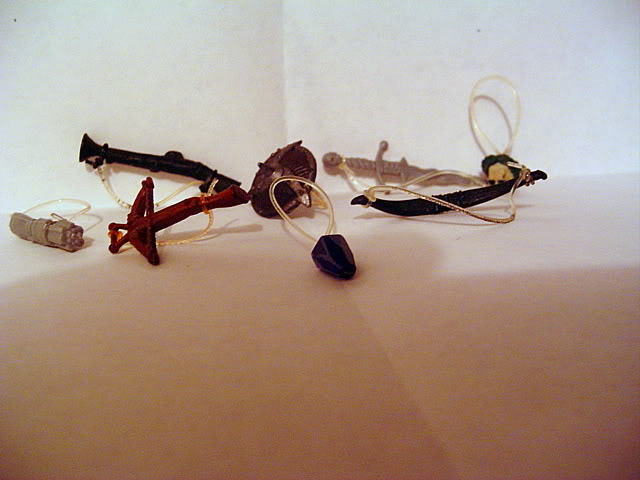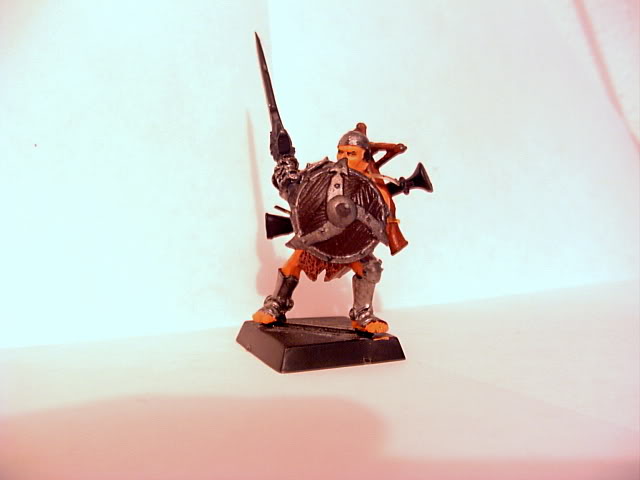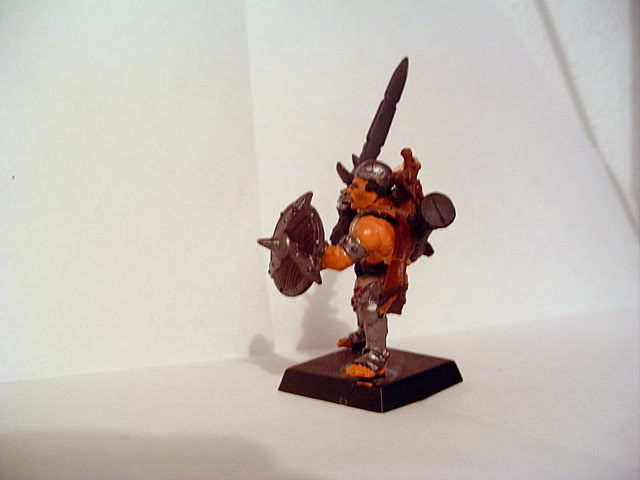Since someone had hinted at needing an option for a model with a blunderbuss, I thought I would add this tutorial, so that others could take advantage of the option to use WYSIWYG. Simply get a few supplies. This one is for the Blunderbuss, but you can use the same technique for most other things.
Blunderbuss option:
Supplies Needed: Blunderbuss weapon, transparent stretchy illusion cord (bead string), super glue (option)
1 - Cut a 3 inch section of the cord.
2 - Tie the Clear String around one end of the Blunderbuss while leaving as much string as possible to be able to
tie the other end.
3 - Adjust the slack of the string using a model for practice to be able to sling this weapon around
any human sized model.
4 - Cut off the excess string on both ends to make it look cleaner. (Note, the excess string was so that you could tie knots easier, as having a shorter length causes the knots to be harder to create)
5 - Option - Use Super Glue to prevent the knots from getting loose. A small dot will suffice.
This same technique can be used for Greatswords, Crossbows, Bows, and other items that you can have a place to tie both ends to.
For Cloaks:
Supplies needed: Cloak, Threading Needle, Needle Nose Pliers, Transparent Stretchy Illusion Cord, Hammer (option)
1 - Cut off 6 inch section of cord
2 - Using the needle nose pliers, grip the threading needle and start working it in a twisting motion on the end of the claok where it hangs over the shoulders. Do not force it in, as the cloak clasps will break. Take your time, and patience is needed. (Option - If you can place the cloak to where the clasps are on a solid edge, so that they won't bend, you can place the needle on the clasp of the cloak, and use a hammer to get the needle to create the hole that will serve as the loop to thread the cord through. Be careful, because if the cloak clasp is not on a sturdy surface, and is able to bend, it will possibly break off)
4 - Complete same steps for the other clasp.
3 - Once you have the needle through, remove it and make sure that the hole is big enough to thread the cord through. Tip for this step is that the cord is stretchy, and you can place the cord at the hole, and push it through with the needle, as it won't hurt the thread.
4 - Thread the cord through one clasp and tie the knot on the TOP SIDE of the cloak so that the majority of the thread is on the bottom side of the cloak. Do not tie the knot to where it is on the underside of the cloak.
5 - Thread the cord back through the other side of the cloak via the other clasp.
6 - Leave enough slack so that you can stretch the loop of thread over most models that would use a cloak as an option.
7 - Tie a knot to secure the string with the knot on the outside of the cloak again. You should have PLENTY of string to get a goo knot on this side as well.
8 - Cut the excess of the string from the knot, and you can now reuse this excess string on another item (no waste!)
9 - OPTION - Use Super Glue to keep the knots in place
10 - If you don't want to use the needle and hole method, then use the following method, which is used for shields.
For Shields:
Supplies Needed: Shield, Super Glue, Transparent Stretchy Illusion Cord, Scoring device of your choice (Small file, Dental Tool, etc)
1 - Cut off a 1 1/2 inch section of cord (one and a half inches)
2 - On the inside of the shield, using a scoring tool of your choice, score the shield by 'drawing' a line that divides the shield in half. Think of geometry, and this would simply be the line that would be called it's diameter.
3 - Once scored, you now know where the cord will be placed. Grab the shield so that you can place the string on the scored area with your other hand. The shield should be held so that the scored line runs north/south, and your fingers holding the shield are on the west or east side of the shield.
4 - With your other hand, place a small amount of glue on SOUTH side of the shield on the scored line, or the bottom, for those of you that are directionally challenged.
5 - Put down the glue, and grab the string
6 - Place the string on the glue, lining it up with the scored line so that the excess string hangs down and away from the shield. Place about 1/4 of an inch of ths tring on the glue and push it down for a few seconds with any spare item, such as a toothpick, piece of scrap wood, metal utensil, etc. This is only to make sure it gets a good secured contact with the glue. The glue can be scraped off of metal items, but wooden ones can not get it removed.
7 - Allow the first section to dry for a minute or two
8 - Now, once it's dried, turn the shield to where the back of the shield is facing you again, and the glued string is now facing up/north.
9 - You should now be able to repeat the same step, placing glue on the scored section, looping the string on to the scored section, and making sure to use something to keep the string secured until it dries. (This is the hardest step, as the looping of the string causes the string to try and come off. Please use something to clamp down the string, or make sure it stays in place for this step)
10 - Now you have your shield that can be placed OVER the shoulders of a model!
11 - Option - To place the shield onto a hand, so that the model is 'holding' it, you can do this easily. Place the loop of string on the OUTSIDE of the hand, so that the interior of the shield is facing away from the model. Then, twist the shield enough to wind up the string. Then, STRETCH the shield away from the model's hand, pivot it onto the hand as if he was holding it properly,. Now, your model is holding the shield as if it was natural!
Lastly, Quivers and other items that you can't tie the cord to both ends can use a combination of these techniques. Tie one end to a place that can use a knot, and the other end, score it and glue the other end of the string. I hope it helps, as I try to use the WYSIWYG method, but I would not be able to have the multitude of variations for each model. This allows anyone to be able to use items on most any model.
Amulets and Pendants can be created too, but with a LOT of patience! Take a look at some example items:







